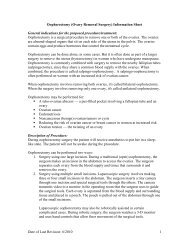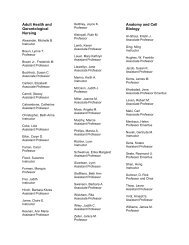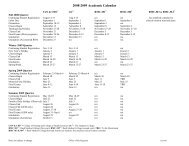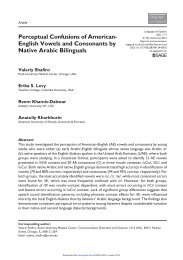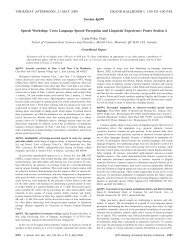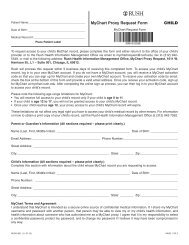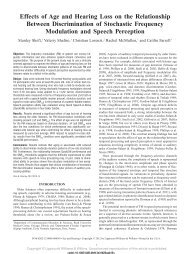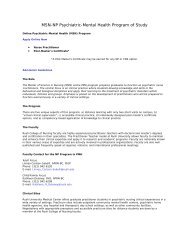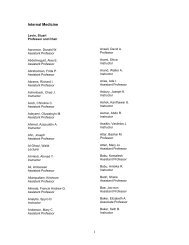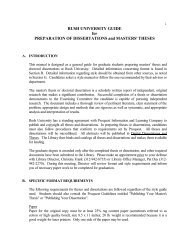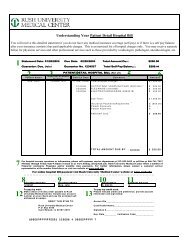what you need to know about having a procedure - Rush University ...
what you need to know about having a procedure - Rush University ...
what you need to know about having a procedure - Rush University ...
You also want an ePaper? Increase the reach of your titles
YUMPU automatically turns print PDFs into web optimized ePapers that Google loves.
WHAT YOU NEED TO KNOW<br />
ABOUT HAVING A PROCEDURE<br />
www.rush.edu
Additional Instructions From Your Physician<br />
____________________________________________________<br />
____________________________________________________<br />
____________________________________________________<br />
____________________________________________________<br />
____________________________________________________<br />
____________________________________________________<br />
____________________________________________________<br />
____________________________________________________<br />
____________________________________________________<br />
____________________________________________________<br />
____________________________________________________<br />
____________________________________________________<br />
____________________________________________________<br />
____________________________________________________<br />
____________________________________________________<br />
____________________________________________________<br />
____________________________________________________<br />
____________________________________________________<br />
____________________________________________________<br />
____________________________________________________<br />
____________________________________________________<br />
____________________________________________________
CONTENTS<br />
Before You Arrive 2<br />
When You Arrive 6<br />
WhAt <strong>to</strong> expect After Your <strong>procedure</strong> 7<br />
GoinG home 8<br />
prepArinG Your child for A <strong>procedure</strong> 9<br />
AdditionAl informAtion 12<br />
GettinG <strong>to</strong> rush 14<br />
GettinG Around rush 17<br />
Welcome <strong>to</strong> rush university medical center. our staff realizes<br />
that this can be a stressful time, and we will do everything we can<br />
<strong>to</strong> ensure that <strong>you</strong> receive the very best care and that <strong>you</strong>r visit <strong>to</strong><br />
rush goes smoothly.<br />
this guide was created <strong>to</strong> help <strong>you</strong> prepare for <strong>you</strong>r <strong>procedure</strong>.<br />
We hope <strong>you</strong> find this information useful. if <strong>you</strong> have any<br />
questions or concerns during <strong>you</strong>r time at rush, please speak <strong>to</strong><br />
any member of <strong>you</strong>r health care team.<br />
W h A t Y o u n e e d t o K n o W A B o u t h A v i n G A p r o c e d u r e 1
2<br />
BEFOrE YOu arriVE<br />
MakE SurE all PrE-PrOCEdural TESTiNg iS COMPlETEd<br />
Your doc<strong>to</strong>r or another health care professional will meet with <strong>you</strong> before <strong>you</strong>r<br />
<strong>procedure</strong> <strong>to</strong> discuss routine pre-procedural tests. Your physician will <strong>need</strong><br />
<strong>to</strong> receive the results of all pre-<strong>procedure</strong> tests at least 3 days before <strong>you</strong>r<br />
scheduled <strong>procedure</strong> <strong>to</strong> avoid any delays or cancellations. Your doc<strong>to</strong>r may<br />
discuss these tests with <strong>you</strong> in more detail.<br />
ExPECT Our CallS<br />
Before <strong>you</strong> come <strong>to</strong> rush, staff from the following areas may contact <strong>you</strong>:<br />
Hospital Registration<br />
A staff member will call <strong>to</strong> verify <strong>you</strong>r insurance coverage. if <strong>you</strong>r scheduled<br />
<strong>procedure</strong> is within 48 hours and <strong>you</strong> have not been contacted, please call the<br />
Admitting/registration department at (312) 942-5700.<br />
Anesthesiology<br />
if <strong>you</strong> are receiving anesthesia for <strong>you</strong>r <strong>procedure</strong>, a member of the anesthesia<br />
team may attempt <strong>to</strong> contact <strong>you</strong> <strong>to</strong> discuss the anesthesia plan for <strong>you</strong>r<br />
<strong>procedure</strong> and answer questions <strong>about</strong> <strong>you</strong>r prescription medications, anesthesia<br />
and pain management during and after <strong>you</strong>r <strong>procedure</strong>. You will have an<br />
additional opportunity <strong>to</strong> speak with <strong>you</strong>r anesthesia team when <strong>you</strong> arrive<br />
on the day of <strong>you</strong>r <strong>procedure</strong>, if <strong>you</strong> are not reached prior <strong>to</strong> the day of <strong>you</strong>r<br />
<strong>procedure</strong>.<br />
Perioperative Care Unit (PCU)<br />
A nurse from the perioperative care unit (pcu) will call <strong>to</strong> review <strong>you</strong>r<br />
health his<strong>to</strong>ry and instructions for pre-procedural preparation and the time<br />
<strong>you</strong> <strong>need</strong> <strong>to</strong> arrive at rush. if <strong>you</strong> have questions or have not received a phone<br />
call from the pcu by the day before <strong>you</strong>r <strong>procedure</strong>, please call (312) 942-5040<br />
prior <strong>to</strong> 6 p.m. the day before <strong>you</strong>r <strong>procedure</strong>. if <strong>you</strong>r <strong>procedure</strong> is scheduled<br />
on a monday, please call on the friday before <strong>you</strong>r <strong>procedure</strong>. if <strong>you</strong> have<br />
not received confirmation of <strong>you</strong>r <strong>procedure</strong> time by 6 p.m., please call<br />
(312) 947-0500 and ask <strong>to</strong> speak with the operating room charge nurse.<br />
W h A t Y o u n e e d t o K n o W A B o u t h A v i n G A p r o c e d u r e
BEFOrE YOu arriVE<br />
gETTiNg rEadY FOr ThE PrOCEdurE<br />
the following instructions will help prepare <strong>you</strong> for <strong>you</strong>r <strong>procedure</strong> and recovery:<br />
Diet<br />
• As a general rule, <strong>you</strong> should not eat or drink after midnight on the night before<br />
<strong>you</strong>r <strong>procedure</strong>. under rare circumstances, <strong>you</strong> may be given permission <strong>to</strong> have<br />
clear liquids up <strong>to</strong> a few hours before <strong>you</strong>r <strong>procedure</strong>.<br />
• Avoid alcoholic beverages for at least 12 hours before <strong>you</strong>r <strong>procedure</strong>.<br />
Medication<br />
• unless otherwise instructed by <strong>you</strong>r doc<strong>to</strong>r or a member of the anesthesia team,<br />
take <strong>you</strong>r normal morning prescription medications but with only a small sip of<br />
water.<br />
• do not take any vitamins or herbal supplements for at least 12 hours before <strong>you</strong>r<br />
<strong>procedure</strong>.<br />
• do not take oral diabetes medicines. if <strong>you</strong> take insulin for diabetes, check with<br />
<strong>you</strong>r doc<strong>to</strong>r <strong>about</strong> how much <strong>you</strong> should take the day of <strong>you</strong>r <strong>procedure</strong>.<br />
• if <strong>you</strong> take blood-thinning medicines such as coumadin, plavix, aspirin or ibuprofen<br />
(e.g., motrin, nuprin or Advil), ask <strong>you</strong>r doc<strong>to</strong>r if <strong>you</strong> should s<strong>to</strong>p taking<br />
them prior <strong>to</strong> <strong>procedure</strong>.<br />
Other Instructions<br />
• s<strong>to</strong>p smoking at least 2 weeks before <strong>you</strong>r <strong>procedure</strong>, or earlier if possible.<br />
• Bathe with an antibacterial soap the night before or the morning of <strong>you</strong>r<br />
<strong>procedure</strong>. do not apply lotions, creams, powders or deodorant after bathing.<br />
• call <strong>you</strong>r doc<strong>to</strong>r before the day of <strong>you</strong>r <strong>procedure</strong> if <strong>you</strong> develop a fever, cold<br />
or rash.<br />
• if <strong>you</strong> are <strong>having</strong> <strong>you</strong>r period the day of <strong>you</strong>r <strong>procedure</strong>, do not wear a tampon<br />
(wear a pad).<br />
• Arrange <strong>to</strong> have a responsible adult escort <strong>you</strong> home after <strong>you</strong>r <strong>procedure</strong>.<br />
You will not be allowed <strong>to</strong> drive <strong>you</strong>rself home. if <strong>you</strong> are <strong>having</strong> an outpatient<br />
<strong>procedure</strong>, <strong>you</strong> must have a family member or friend with <strong>you</strong> after the <strong>procedure</strong><br />
<strong>to</strong> review <strong>you</strong>r instructions and help <strong>you</strong> home. it is recommended that<br />
<strong>you</strong>r family member or friend remain with <strong>you</strong> during the first 24 hours for <strong>you</strong>r<br />
safety and protection.<br />
• inform <strong>you</strong>r doc<strong>to</strong>r and the anesthesia team if <strong>you</strong> have allergies <strong>to</strong> any<br />
medications or latex.<br />
• patients under 18 years of age must be accompanied by a parent or legal<br />
guardian.<br />
W h A t Y o u n e e d t o K n o W A B o u t h A v i n G A p r o c e d u r e 3
4<br />
BEforE You arriVE<br />
Pack for Your comfort and EfficiEncY<br />
Please bring the following:<br />
• Pho<strong>to</strong> ID (driver’s license or state ID).<br />
• Insurance card and information.<br />
• List of prescription and non-prescription medications<br />
that <strong>you</strong> take (see page 5 for form). You may bring<br />
<strong>you</strong>r medications <strong>to</strong> the hospital, but for reasons of<br />
safety and <strong>Rush</strong> policy, medications will be supplied <strong>to</strong><br />
<strong>you</strong> by the hospital pharmacy during <strong>you</strong>r stay.<br />
• List of past hospitalizations, illnesses, surgeries,<br />
allergies (and allergic reactions) and immunizations.<br />
• Assistive devices, such as walkers, crutches, canes,<br />
hearing aids and magnifying glasses. Please label all<br />
personal items with <strong>you</strong>r name.<br />
• Names and phone numbers of family or friends <strong>to</strong><br />
contact in case of emergency.<br />
• Comfortable clothes <strong>to</strong> wear home.<br />
• Money <strong>to</strong> purchase newspapers, magazines or other<br />
items (limit of $10 in cash).<br />
• Copy of <strong>you</strong>r advance directives, if <strong>you</strong> have such<br />
documents. Advance directives are given <strong>to</strong> <strong>you</strong>r<br />
doc<strong>to</strong>rs and family in case <strong>you</strong> become unable <strong>to</strong><br />
make medical decisions for <strong>you</strong>rself. Advance directives<br />
include a living will and durable power of<br />
at<strong>to</strong>rney for health care. Any person 18 years of age<br />
or older should be informed <strong>about</strong> advance directives.<br />
Patients can request copies of advance directives<br />
when they are admitted <strong>to</strong> <strong>Rush</strong>. For further information,<br />
call <strong>Rush</strong>’s Department of Religion, Health and<br />
Human Values at (312) 942-5571.<br />
If staying overnight, <strong>you</strong> are welcome <strong>to</strong> bring the<br />
following:<br />
• Robe and slippers.<br />
Leave the Rest at Home<br />
Please leave the following<br />
items at home:<br />
• Valuables such as credit<br />
cards, checkbooks, large<br />
amounts of cash and<br />
jewelry.<br />
• Please remove all jewelry (including<br />
wedding, navel and<br />
nose rings). If <strong>you</strong> are unable<br />
<strong>to</strong> remove any of these items,<br />
they will be cut off for safety.<br />
• Personal electrical<br />
appliances, such as hair<br />
dryers, curling irons, electric<br />
shavers, heating pads,<br />
television sets, radios,<br />
cellular telephones and<br />
lap<strong>to</strong>p computers.<br />
We cannot be responsible for<br />
<strong>you</strong>r belongings. If <strong>you</strong> must<br />
bring valuables, ask the staff<br />
<strong>to</strong> deposit them in the hospital<br />
safe. Please be aware that<br />
if <strong>you</strong> <strong>need</strong> <strong>to</strong> deposit items<br />
in our safe, <strong>you</strong>r registration<br />
and discharge process will<br />
require extra time. For <strong>you</strong>r<br />
convenience, we strongly<br />
recommend leaving un<strong>need</strong>ed<br />
items and valuables at home.<br />
• Personal <strong>to</strong>iletries, such as shampoo, deodorant, <strong>to</strong>othbrush, <strong>to</strong>othpaste,<br />
denture cream and moisturizer.<br />
One family member is allowed <strong>to</strong> stay at <strong>you</strong>r bedside overnight.<br />
W H A T Y O U N E E D T O K N O W A B O U T H A V I N G A P R O C E D U R E
BEFOrE YOu arriVE<br />
MEdiCaTiONS aNd SuPPlEMENTS<br />
please list all medications that <strong>you</strong> are currently taking and bring them with <strong>you</strong> <strong>to</strong> the hospital.<br />
medication/supplement What it is for dosage times taken per day last time taken<br />
name<br />
W h A t Y o u n e e d t o K n o W A B o u t h A v i n G A p r o c e d u r e 5
kellogg<br />
Jelke<br />
E d<br />
guest<br />
relations<br />
6<br />
MaiN STrEET<br />
WhEN YOu arriVE<br />
arriVal aT ruSh<br />
check in at the time provided by the<br />
scheduling office. this will be 1.5 <strong>to</strong> 2.5<br />
hours prior <strong>to</strong> the scheduled start of <strong>you</strong>r<br />
<strong>procedure</strong>.<br />
if <strong>you</strong> are parking in the parking garage,<br />
please check in at the admitting/<br />
registration desk, Atrium Building, 1650<br />
W. harrison street, 4th floor. the 4th<br />
floor of the parking garage provides direct<br />
access in<strong>to</strong> the Atrium Building (see map<br />
on page 16). if <strong>you</strong> are valet parking or<br />
being dropped off, please check in at<br />
the admitting/registration desk, Brennan<br />
pavilion, 1620 W. harrison st., 1st floor.<br />
if <strong>you</strong> <strong>need</strong> wheelchair transport,<br />
assistance is available at the valet entrance<br />
of the Brennan pavilion, 1620 W. harrison<br />
street. once <strong>you</strong> are inside, a member of<br />
the guest relations staff can assist <strong>you</strong>.<br />
When <strong>you</strong> arrive at the 4th floor of the<br />
Atrium Building (1) or at the 1st floor the<br />
Brennan pavilion (2), please proceed <strong>to</strong><br />
admitting (see maps below). You will<br />
be asked <strong>to</strong> provide a pho<strong>to</strong> id (driver’s<br />
license or state id) and an insurance card<br />
at this time.<br />
You will receive a hospital wristband<br />
<strong>to</strong> wear. this wristband serves as<br />
<strong>you</strong>r identification while <strong>you</strong> are in<br />
the hospital. You will find that this<br />
identification is checked many times while<br />
<strong>you</strong> are in the hospital. sometimes it may<br />
seem <strong>to</strong>o often; however, this check is<br />
done <strong>to</strong> keep <strong>you</strong> safe.<br />
1<br />
admitting<br />
4th floor<br />
atrium<br />
<strong>to</strong> parking<br />
<strong>to</strong> <strong>to</strong>wer<br />
admitting<br />
1st floor<br />
2<br />
After <strong>you</strong> have completed paperwork in<br />
admitting, <strong>you</strong> will be given directions<br />
<strong>to</strong> the check-in area of the floor where<br />
<strong>you</strong> are <strong>having</strong> <strong>you</strong>r <strong>procedure</strong>. A staff<br />
member will greet <strong>you</strong>.<br />
You will then be escorted <strong>to</strong> the<br />
perioperative care unit (pcu) where <strong>you</strong><br />
will have <strong>you</strong>r temperature, pulse, blood<br />
pressure, height and weight taken and<br />
recorded. the nursing staff will review<br />
<strong>you</strong>r chart, and <strong>you</strong> will change clothing<br />
for <strong>you</strong>r <strong>procedure</strong>.<br />
if <strong>you</strong> are scheduled <strong>to</strong> receive anesthesia,<br />
<strong>you</strong> will meet with the anesthesia team,<br />
who will start <strong>you</strong>r intravenous (iv) access<br />
and administer any medications before<br />
<strong>you</strong>r <strong>procedure</strong>.<br />
Before <strong>you</strong>r <strong>procedure</strong> <strong>you</strong> will be asked <strong>to</strong><br />
sign consent forms <strong>to</strong> allow <strong>you</strong>r doc<strong>to</strong>rs<br />
<strong>to</strong> perform the <strong>procedure</strong> and, if <strong>need</strong>ed, a<br />
blood transfusion.<br />
While <strong>you</strong>r physician and the operating<br />
or <strong>procedure</strong> room staff prepare for <strong>you</strong>r<br />
<strong>procedure</strong>, there will be a waiting period. if<br />
<strong>you</strong> have any questions or concerns during<br />
this time, please contact any of the pcu<br />
staff or ask <strong>to</strong> speak <strong>to</strong> our administra<strong>to</strong>r<br />
of patient and family satisfaction. they will<br />
be happy <strong>to</strong> assist <strong>you</strong>.<br />
two or three family members or friends<br />
may stay with <strong>you</strong> at the discretion of<br />
staff until it is time for <strong>you</strong>r <strong>procedure</strong>.<br />
tvs are provided in each area for <strong>you</strong>r<br />
comfort.<br />
Tower<br />
W h A t Y o u n e e d t o K n o W A B o u t h A v i n G A p r o c e d u r e<br />
See page 16 and 17<br />
for entire 4th floor and<br />
<strong>Rush</strong> campus maps.
WhaT TO ExPECT aFTEr YOur PrOCEdurE<br />
WhErE YOu Will gO aFTEr PrOCEdurE<br />
After <strong>you</strong>r <strong>procedure</strong>, <strong>you</strong> will recover in the recovery room or in an intensive<br />
care unit, as appropriate for <strong>you</strong>r <strong>procedure</strong>. during <strong>you</strong>r recovery, the staff will<br />
closely moni<strong>to</strong>r <strong>you</strong>r heart rate, breathing and blood pressure until <strong>you</strong> are ready<br />
<strong>to</strong> be discharged home or moved <strong>to</strong> an inpatient room.<br />
WhEN YOu WakE uP<br />
You may be uncomfortable after <strong>you</strong>r <strong>procedure</strong>. tell <strong>you</strong>r doc<strong>to</strong>r or nurse if <strong>you</strong><br />
have any of the following:<br />
• nausea<br />
• dizziness<br />
• pain<br />
• sore throat<br />
these are common aftereffects of anesthesia and <strong>having</strong> a <strong>procedure</strong>. Your<br />
doc<strong>to</strong>r may prescribe medication <strong>to</strong> relieve these discomforts.<br />
You may wake up with a small tube (or catheter) in <strong>you</strong>r bladder. the catheter<br />
helps <strong>you</strong> urinate and helps <strong>you</strong>r doc<strong>to</strong>r <strong>know</strong> that <strong>you</strong>r kidneys and bladder are<br />
working normally. A staff member can easily remove this tube when <strong>you</strong>r doc<strong>to</strong>r<br />
says <strong>you</strong> are ready.<br />
ViSiTaTiON aFTEr YOur PrOCEdurE<br />
Outpatients: if <strong>you</strong> are <strong>having</strong> an outpatient <strong>procedure</strong>, visitation is permitted<br />
once <strong>you</strong> are awake and able <strong>to</strong> move <strong>to</strong> a recliner, typically after 1 hour.<br />
Inpatients: if <strong>you</strong> are staying in the hospital for a longer period of time, <strong>you</strong>r<br />
family may visit once <strong>you</strong> are transferred <strong>to</strong> <strong>you</strong>r room, typically within 2 hours.<br />
if <strong>you</strong> are still in the recovery area after 2 hours, <strong>you</strong>r family may be permitted<br />
<strong>to</strong> visit. visitation in the recovery area is limited <strong>to</strong> 2 people. if <strong>you</strong> have a large<br />
family, please designate which 2 family members will visit.<br />
BEgiN TO ParTiCiPaTE iN YOur rECOVErY<br />
recovery goes more smoothly if <strong>you</strong> become physically active soon after <strong>you</strong>r<br />
<strong>procedure</strong>. for this reason, the staff will ask <strong>you</strong> <strong>to</strong> move and walk around as<br />
soon as it is appropriate. You should gradually increase <strong>you</strong>r activity level while<br />
giving <strong>you</strong>rself time <strong>to</strong> rest.<br />
You may be asked <strong>to</strong> complete deep breathing and coughing exercises <strong>to</strong> help<br />
prevent fluids from building up in <strong>you</strong>r lungs, a condition that can lead <strong>to</strong><br />
pneumonia. <strong>to</strong> help <strong>you</strong> get better faster, staff members may frequently ask<br />
<strong>you</strong> <strong>to</strong> breathe deeply and cough.<br />
W h A t Y o u n e e d t o K n o W A B o u t h A v i n G A p r o c e d u r e 7
8<br />
gOiNg hOME<br />
Your doc<strong>to</strong>r will decide when <strong>you</strong> are ready <strong>to</strong> be discharged from the hospital.<br />
You will receive instructions on continuing <strong>you</strong>r recovery at home.<br />
CarE FOr YOur iNCiSiON Or PuNCTurE SiTE<br />
An incision or puncture site may be closed with staples or stitches. Your incision<br />
or puncture site may be covered by a bandage or dressing. there also may be a<br />
tube in the incision and dressing.<br />
the following are tips <strong>to</strong> help <strong>you</strong>r incision heal quickly:<br />
• Keep the area clean and dry.<br />
• Wash <strong>you</strong>r hands before and after <strong>to</strong>uching the area.<br />
• take warm showers instead of baths (if permitted in <strong>you</strong>r doc<strong>to</strong>r’s<br />
instructions).<br />
aSk QuESTiONS<br />
Before <strong>you</strong> leave, <strong>you</strong> should ask the following<br />
questions:<br />
• What medicine(s) will i be taking at home? how<br />
much medicine should i take? When should i<br />
take it?<br />
• What is the best way <strong>to</strong> care for my incision(s)?<br />
• What signs of infection should i watch for?<br />
• What should i eat?<br />
• how should i bathe, and how often?<br />
• When should i schedule my follow-up visit?<br />
• how much physical activity can i handle?<br />
• When can i resume sexual activity?<br />
• can i drive?<br />
• When can i go back <strong>to</strong> work?<br />
Be sure that <strong>you</strong> and <strong>you</strong>r family understand<br />
all the instructions given <strong>to</strong> <strong>you</strong>. if <strong>you</strong> have<br />
questions when <strong>you</strong> get home, call <strong>you</strong>r doc<strong>to</strong>r.<br />
W h A t Y o u n e e d t o K n o W A B o u t h A v i n G A p r o c e d u r e<br />
When <strong>to</strong> Call Your Doc<strong>to</strong>r<br />
You should contact <strong>you</strong>r<br />
doc<strong>to</strong>r if any of the<br />
following occur:<br />
• You develop a fever<br />
higher than 101 degrees<br />
Fahrenheit.<br />
• You experience unusual<br />
redness or drainage around<br />
the incision or puncture site.<br />
• You develop a rash around<br />
the incision or puncture site.<br />
• Your incision or puncture<br />
site bleeds or <strong>you</strong> have<br />
an open incision. Apply<br />
pressure <strong>to</strong> affected area<br />
<strong>to</strong> control bleeding; place<br />
a bandage, if <strong>need</strong>ed.<br />
• Your medicine is not<br />
controlling <strong>you</strong>r pain.
PrEPariNg YOur Child FOr a PrOCEdurE<br />
TalkiNg TO YOur Child aBOuT a PrOCEdurE<br />
A <strong>procedure</strong> can be a stressful event at any age, but it can be especially<br />
frightening and overwhelming for a child. We encourage families <strong>to</strong> tell their<br />
children why they are going <strong>to</strong> the hospital, and <strong>what</strong> will happen during their<br />
hospital stay. providing <strong>you</strong>r child with this information is very important because<br />
children who are well prepared for their hospital experience cope better and<br />
recover more quickly than those who have not been prepared.<br />
We understand that preparing a child for a <strong>procedure</strong> can be difficult for<br />
parents. Along with feeling concern for <strong>you</strong>r child’s health, it is common <strong>to</strong><br />
worry <strong>about</strong> how <strong>you</strong> will talk with <strong>you</strong>r child <strong>about</strong> the upcoming event. here<br />
are some helpful tips:<br />
• Wait until just a day or two before the <strong>procedure</strong> <strong>to</strong> tell very <strong>you</strong>ng children<br />
<strong>about</strong> going <strong>to</strong> the hospital.<br />
• explain why the <strong>procedure</strong> is <strong>need</strong>ed. reassure <strong>you</strong>r child that they did nothing<br />
wrong <strong>to</strong> cause this. Young children often think going <strong>to</strong> the hospital is a punishment<br />
for something they did wrong.<br />
• Give simple, honest explanations <strong>about</strong> <strong>what</strong> will happen before, during and<br />
after a <strong>procedure</strong>.<br />
• stress that he or she will be asleep when the <strong>procedure</strong> takes place. it is usually<br />
best not <strong>to</strong> give a detailed explanation of the <strong>procedure</strong> or repair that takes place<br />
after the child is asleep. for example, simply stating, “the doc<strong>to</strong>r will fix <strong>you</strong>r leg”<br />
or “the doc<strong>to</strong>r will take out <strong>you</strong>r <strong>to</strong>nsils” is often all that is necessary.<br />
• use nonthreatening words, such as “make a small opening” instead of “cut,” or<br />
“feel a small pinch” instead of “hurt.”<br />
• let <strong>you</strong>r child <strong>know</strong> that <strong>you</strong> will not be able <strong>to</strong> be in the <strong>procedure</strong> room with<br />
him or her during the <strong>procedure</strong>, but that he or she will be well cared for by the<br />
doc<strong>to</strong>rs and nurses. emphasize that <strong>you</strong> will be nearby and reunited soon after<br />
the <strong>procedure</strong>.<br />
• mention possible discomfort <strong>you</strong>r child may feel after the <strong>procedure</strong>.<br />
• encourage <strong>you</strong>r child <strong>to</strong> ask questions.<br />
• use educational materials, such as “doc<strong>to</strong>r <strong>to</strong>ys,” dolls and books <strong>about</strong> the<br />
hospital <strong>to</strong> give <strong>you</strong>r child an opportunity <strong>to</strong> play or talk out his or her feelings.<br />
• Allow <strong>you</strong>r child the opportunity <strong>to</strong> make some choices, such as <strong>what</strong> <strong>to</strong>y <strong>to</strong><br />
bring <strong>to</strong> the hospital or <strong>what</strong> he or she would like <strong>to</strong> wear that day. this can<br />
really make a difference! children feel better when they have some control over<br />
<strong>what</strong> is happening.<br />
W h A t Y o u n e e d t o K n o W A B o u t h A v i n G A p r o c e d u r e 9
10<br />
PrEPariNg YOur Child FOr a PrOCEdurE<br />
<strong>Rush</strong>’s Special Program <strong>to</strong> Prepare Children for a Procedure<br />
rush offers a special program <strong>to</strong> help <strong>you</strong> and <strong>you</strong>r child prepare for a<br />
<strong>procedure</strong>. this free program is held weekly and is designed for parents and<br />
future pediatric patients. the program includes a <strong>to</strong>ur of the <strong>procedure</strong> room<br />
areas, admitting and pediatric unit. in addition <strong>to</strong> seeing areas they will be<br />
visiting, the program gives children the opportunity <strong>to</strong> see and handle some<br />
of the medical equipment doc<strong>to</strong>rs and nurses will use <strong>to</strong> care for them.<br />
please call rush’s child life services at (312) 942-7842 <strong>to</strong> register for the<br />
<strong>to</strong>ur or speak <strong>to</strong> someone <strong>about</strong> preparing <strong>you</strong>r child for a <strong>procedure</strong>.<br />
The Virtual Tour<br />
Because we <strong>know</strong> that many busy families are unable <strong>to</strong> bring their child <strong>to</strong><br />
the hospital for a live <strong>to</strong>ur, rush has created an interactive virtual <strong>to</strong>ur of the<br />
operating room areas and pediatric unit. the virtual <strong>to</strong>ur is in cd format and is<br />
provided <strong>to</strong> <strong>you</strong> at no charge. Watching the <strong>to</strong>ur will help <strong>you</strong> and <strong>you</strong>r child<br />
become more familiar with the hospital itself and learn <strong>about</strong> some of the things<br />
that will happen the day of <strong>procedure</strong>. You can obtain one by calling child life<br />
services at (312) 942-7842.<br />
Make Child Care Arrangements for Your Other Children<br />
please make child care arrangements for <strong>you</strong>r other children. if <strong>you</strong>r child is<br />
<strong>having</strong> an outpatient <strong>procedure</strong>, plan on the child recovering in the procedural<br />
area for approximately 1 <strong>to</strong> 3 hours after the <strong>procedure</strong> is over.<br />
About Medications<br />
sedation medications are used (as necessary) <strong>to</strong> reduce anxiety in the child<br />
before going <strong>to</strong> the <strong>procedure</strong> room. the medications are administered as<br />
painlessly as possible. oral medications are used instead of injections, when<br />
possible. You will have the opportunity <strong>to</strong> discuss pre-operative sedation with<br />
<strong>you</strong>r anesthesiologist before the <strong>procedure</strong>.<br />
W h A t Y o u n e e d t o K n o W A B o u t h A v i n G A p r o c e d u r e
PrEPariNg YOur Child FOr a PrOCEdurE<br />
Where <strong>to</strong> Wait During Your Child’s Procedure<br />
While <strong>you</strong>r child is in <strong>procedure</strong>, <strong>you</strong> can wait in the smith family lounge on<br />
the floor where child’s <strong>procedure</strong> is taking place. please proceed <strong>to</strong> the smith<br />
family lounge after <strong>you</strong>r child goes in<strong>to</strong> the <strong>procedure</strong> room, check in with the<br />
volunteer and get a pager so <strong>you</strong> may be reached as soon as the <strong>procedure</strong> is<br />
complete. You will be called <strong>to</strong> be with <strong>you</strong>r child soon after he or she awakens<br />
from the anesthesia.<br />
Visiting and Spending the Night With Your Child<br />
for children who stay in the hospital after a <strong>procedure</strong>, visiting hours are from<br />
11 a.m. <strong>to</strong> 8 p.m. parents may visit at any time; however, only one parent<br />
may sleep at the bedside. healthy siblings are permitted <strong>to</strong> visit during regular<br />
visiting hours.<br />
Elective Procedures<br />
if <strong>you</strong>r child becomes ill prior <strong>to</strong> an elective <strong>procedure</strong>, the <strong>procedure</strong> may <strong>need</strong><br />
<strong>to</strong> be canceled. please call <strong>you</strong>r physician’s office if the child experiences fever,<br />
cough, runny nose or other symp<strong>to</strong>ms of illness the week before the <strong>procedure</strong>.<br />
Remember <strong>to</strong> Follow Doc<strong>to</strong>r’s Orders About Drinking and Eating<br />
You will receive a call from the hospital the day before <strong>you</strong>r child’s <strong>procedure</strong> <strong>to</strong><br />
confirm the time of the <strong>procedure</strong> and inform <strong>you</strong> of the time <strong>to</strong> s<strong>to</strong>p feeding<br />
<strong>you</strong>r child. follow the feeding instructions exactly, because the <strong>procedure</strong> may<br />
be canceled if the child has had something <strong>to</strong> eat or drink close <strong>to</strong> the time of<br />
the <strong>procedure</strong>.<br />
W h A t Y o u n e e d t o K n o W A B o u t h A v i n G A p r o c e d u r e 11
12<br />
addiTiONal iNFOrMaTiON<br />
iMPOrTaNT dOCuMENTS<br />
every <strong>procedure</strong> involves risk. Below are two kinds of documents that are<br />
commonly completed by patients before a <strong>procedure</strong>.<br />
General Informed Consent<br />
A form is signed prior <strong>to</strong> the <strong>procedure</strong>, after a discussion of the risks and<br />
benefits of the <strong>procedure</strong> with the doc<strong>to</strong>r. this form grants permission <strong>to</strong> proceed<br />
with <strong>you</strong>r <strong>procedure</strong>.<br />
Advance Directives<br />
formal documents, written before <strong>you</strong> get seriously ill, state <strong>you</strong>r choices<br />
for health care, or identify the person <strong>to</strong> make those choices if <strong>you</strong> are unable<br />
<strong>to</strong> do so.<br />
aNESThESia<br />
Anesthesia is medication <strong>to</strong> prevent pain during a <strong>procedure</strong>. Before <strong>you</strong>r<br />
<strong>procedure</strong>, a member of the anesthesia team will take <strong>you</strong>r medical his<strong>to</strong>ry and<br />
examine <strong>you</strong> <strong>to</strong> determine <strong>what</strong> kind of anesthesia <strong>to</strong> use based on <strong>you</strong>r health<br />
and the type of <strong>procedure</strong> <strong>you</strong> are <strong>having</strong>. he or she will also talk <strong>about</strong> the risks<br />
and benefits of the anesthesia plan, as well as the alternatives.<br />
on the day of the <strong>procedure</strong>, a member of the anesthesia team will insert an iv<br />
tube in <strong>you</strong>r arm or hand vein <strong>to</strong> administer medications. in the <strong>procedure</strong> room,<br />
the anesthesia staff will moni<strong>to</strong>r <strong>you</strong>r heart rate, blood pressure, breathing and<br />
blood-oxygen level.<br />
there are three types of anesthesia: general, regional and local (with or without<br />
sedation).<br />
General Anesthesia<br />
General anesthesia means <strong>you</strong>r entire body is “asleep” for the <strong>procedure</strong>. this<br />
usually occurs in two stages. first, <strong>you</strong> will receive a drug through <strong>you</strong>r iv tube<br />
that will make <strong>you</strong> drift off <strong>to</strong> sleep and become unaware of <strong>what</strong> is going on<br />
around <strong>you</strong>. the second stage of general anesthesia keeps <strong>you</strong> asleep through<br />
<strong>you</strong>r <strong>procedure</strong>. You may breathe anesthesia medication through a mask or<br />
breathing tube, or receive it through <strong>you</strong>r iv tube.<br />
Regional Anesthesia<br />
regional anesthesia numbs certain areas of the body so that <strong>you</strong> do not feel pain.<br />
common types of regional anesthesia are epidural, spinal and caudal anesthesia.<br />
All of these can numb large areas of <strong>you</strong>r body from <strong>you</strong>r abdomen down <strong>to</strong><br />
<strong>you</strong>r feet. Another option is called a peripheral nerve block, which numbs smaller<br />
areas of <strong>you</strong>r body. With regional anesthesia, <strong>you</strong> may receive other drugs that<br />
will make <strong>you</strong> drowsy or keep <strong>you</strong> in a light sleep.<br />
W h A t Y o u n e e d t o K n o W A B o u t h A v i n G A p r o c e d u r e
additional inforMation<br />
Local Anesthesia<br />
For some <strong>procedure</strong>s, anesthetic drugs can be injected right around the area<br />
of the <strong>procedure</strong> <strong>to</strong> numb the area locally. You may be awake and aware<br />
during <strong>you</strong>r <strong>procedure</strong>, or a member of the anesthesia team may give <strong>you</strong><br />
medicine that makes <strong>you</strong> drowsy or puts <strong>you</strong> in a light sleep. Whichever type of<br />
anesthesia <strong>you</strong> have, the <strong>procedure</strong> room or anesthesia staff will closely moni<strong>to</strong>r<br />
<strong>you</strong>r vital signs throughout the <strong>procedure</strong>.<br />
Sedation<br />
Sedation involves the use of pain relievers and sedative drugs <strong>to</strong> reduce or<br />
minimize discomfort during <strong>procedure</strong>s. Patients can receive medications that<br />
will permit them <strong>to</strong> speak and respond <strong>to</strong> their health care providers during a<br />
<strong>procedure</strong>. Sedation can also be provided <strong>to</strong> make <strong>you</strong> very drowsy or keep <strong>you</strong><br />
in a light sleep. Sedation is commonly used in combination with local anesthesia<br />
and with regional anesthesia. It may also be used alone for noninvasive<br />
<strong>procedure</strong>s.<br />
Controlling Pain after a ProCedure<br />
As <strong>you</strong> recover, <strong>you</strong>r doc<strong>to</strong>r will order an appropriate medication for <strong>you</strong> based<br />
on <strong>you</strong>r condition. The nursing staff will assess <strong>you</strong>r pain medication <strong>need</strong>s<br />
throughout <strong>you</strong>r stay.<br />
Two common methods of controlling pain are epidural analgesia (or other forms<br />
of nerve blocks) and intravenous patient-controlled analgesia pumps.<br />
Epidural Analgesia/Regional Nerve Blocks<br />
Epidural analgesia is a common method of pain control for patients who have<br />
undergone a <strong>to</strong>tal joint replacement, a Cesarean delivery or another <strong>procedure</strong> on<br />
the abdomen or chest.<br />
A small plastic tube is placed in <strong>you</strong>r back before <strong>procedure</strong> that delivers pain<br />
medicine continuously right <strong>to</strong> the nerves that “create” pain. The staff can<br />
control the amount of pain medication with a special pump during and after <strong>you</strong>r<br />
<strong>procedure</strong>.<br />
Regional nerve block techniques can also be used in a similar manner <strong>to</strong> control pain<br />
after <strong>procedure</strong>s involving the arms or legs.<br />
Intravenous Patient-Controlled Analgesia (PCA) Pumps<br />
A PCA pump delivers a prescribed amount of pain medication in<strong>to</strong> <strong>you</strong>r arm vein<br />
through an IV tube. You can control the amount of pain medication that flows in<strong>to</strong><br />
<strong>you</strong>r blood by pressing a but<strong>to</strong>n on a hand-held device attached <strong>to</strong> the pump. The<br />
pump is programmed so that it will not deliver <strong>to</strong>o much pain medication.<br />
IMPORTANT: Only the patient should use the PCA but<strong>to</strong>n.<br />
W H A T Y O U N E E D T O K N O W A B O U T H A V I N G A P R O C E D U R E 13
14<br />
gETTiNg TO ruSh<br />
rush university medical center is located just off the eisenhower expressway<br />
(i-290), five minutes west of chicago’s loop. it is easily accessible by car and<br />
public transportation.<br />
By Car<br />
From the north:<br />
• take the Kennedy expressway (i-90/94) <strong>to</strong> the eisenhower expressway (i-290).<br />
• drive west on the eisenhower <strong>to</strong> the Ashland-paulina exit.<br />
• turn south (left) on Ashland Avenue <strong>to</strong> harrison street.<br />
• turn west (right) <strong>to</strong> rush.<br />
From the west:<br />
• take the eisenhower expressway (i-290) <strong>to</strong> the Ashland-paulina exit.<br />
• drive straight one block <strong>to</strong> Ashland Avenue.<br />
• turn south (right) <strong>to</strong> harrison street.<br />
• turn west (right) <strong>to</strong> rush.<br />
From the southwest:<br />
• take the stevenson expressway (i-55) <strong>to</strong> the Ashland exit.<br />
• drive north (left) on Ashland Avenue <strong>to</strong> harrison street.<br />
• turn west (left) <strong>to</strong> rush.<br />
From down<strong>to</strong>wn Chicago:<br />
• drive west on congress parkway, which becomes the eisenhower expressway<br />
(i-290).<br />
• take the Ashland-paulina exit.<br />
• turn south (left) on Ashland Avenue <strong>to</strong> harrison street.<br />
• turn west (right) <strong>to</strong> rush.<br />
W h A t Y o u n e e d t o K n o W A B o u t h A v i n G A p r o c e d u r e
gETTiNg TO ruSh<br />
Parking<br />
the maps on pages 16 and 17 indicate where parking garages are located at<br />
rush. the following discount garage parking options are available for patients<br />
and visi<strong>to</strong>rs:<br />
• A senior citizen’s discount is available for patients and visi<strong>to</strong>rs who show their<br />
senior citizen or medicare cards when leaving the garage.<br />
• discount parking coupon booklets are available and may be purchased at the<br />
guest relations desks in the 4th floor Atrium Building lobby and the 4th floor<br />
Armour Academic center entrance from the parking garage. discount coupons<br />
are not valid for valet parking.<br />
people with disabilities with proper identification receive a discounted rate for<br />
valet parking. for people who <strong>need</strong> wheelchair transport, assistance is available<br />
at the valet parking entrances at the hospital’s main entrance (the Brennan<br />
pavilion), the Johns<strong>to</strong>n r. Bowman center and the professional Building (see<br />
below for addresses and phone numbers). designated parking for people with<br />
disabilities is available on the 4th and 5th floor levels of section A in the garage.<br />
A valid disability license plate or placard must be visible.<br />
valet parking is available at the hospital’s main entrance, 1620 W. harrison st.,<br />
(312) 942-7442; the Bowman center, 710 s. paulina st., (312) 942-7000; and the<br />
professional Building,1725 W. harrison st., (312) 942-3720. discount coupons are<br />
not valid at the valet parking sites.<br />
By Public Transportation<br />
• “el” trains: rush is served by the Blue line (at the illinois medical district s<strong>to</strong>p)<br />
and the pink line (at the polk s<strong>to</strong>p).<br />
• Bus routes: the primary bus routes <strong>to</strong> rush are the 7 harrison bus (weekdays)<br />
and the 126 Jackson bus (weekends).<br />
• times and routes for public transportation may be obtained by calling the<br />
regional transportation Authority (rtA) at (312) 836-7000.<br />
• the valet parking and information desk staff in the hospital’s main entrance can<br />
call a taxi for <strong>you</strong>.<br />
W h A t Y o u n e e d t o K n o W A B o u t h A v i n G A p r o c e d u r e 15
16<br />
GETTING TO RUSH<br />
campUS map<br />
NORTH<br />
KEY<br />
Hospital<br />
parking<br />
W H A T Y O U N E E D T O K N O W A B O U T H A V I N G A P R O C E D U R E<br />
cab Stand<br />
Emergency Valet<br />
Bike Rack<br />
cTa Train
GETTING AROUND RUSH<br />
FOURTH FlOOR MAp<br />
KEY<br />
Emergency public Eleva<strong>to</strong>rs Restrooms<br />
Restaurant<br />
ATM<br />
Vending<br />
Hospital<br />
parking<br />
Information<br />
Valet<br />
Registration<br />
lounge<br />
Coffee Shop<br />
Gift Shop<br />
pharmacy<br />
Chapel<br />
NORTH<br />
W H A T Y O U N E E D T O K N O W A B O U T H A V I N G A P R O C E D U R E 17
P-2651 12/11<br />
We hope this booklet has been helpful.<br />
By keeping <strong>you</strong> informed, we hope <strong>to</strong> lessen <strong>you</strong>r anxiety<br />
and encourage <strong>you</strong>r participation in <strong>you</strong>r care.<br />
produced by the rush patient education planning and development oversight committee<br />
in conjunction with a multidisciplinary team of health care professionals, which includes<br />
physicians, nurses and allied health professionals.<br />
The information contained in this brochure is believed <strong>to</strong> be accurate; however, any questions <strong>about</strong> <strong>you</strong>r individual<br />
health concerns or treatments should be referred <strong>to</strong> <strong>you</strong>r physician.<br />
rush is a not-for-profit health care, education and research<br />
enterprise comprising rush university medical center,<br />
rush university, rush oak park hospital and rush health.



